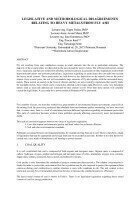Air monitoring
LEGISLATIVE AND METHODOLOGICAL DISAGREEMENTS RELATING TO HEAVY METALS FROM FLY ASH
Oct 06 2014
Author: Lecturer eng. Eugen Traista, PhD, Lecturer chem. Aronel Matei, PhD, Lecturer eng. Ioan Dumitrescu, PhD, Eng. Puscas Ionel and Eng. Tamaioaga Sorin on behalf of CEM
ABSTRACT
Fly ash resulting from coal combustion escapes in small amounts into the air as particulate emissions. The majority of these particulates are deposited in the area around the power station. The airborne particulates spread over a large area and then are removed by dilution, moisture and rain. Legislation or other regulations restrict both deposited particulates and airborne particulates. Legislation regarding air particulates does not take into account the heavy metal content. These particulates are laid down by dry deposition on the topsoil close to the power station. Over several years, the soil will accumulate large amounts of fly ash together with the associated heavy metals. These metals are mainly in the form of silicates and they are not covered by regulations that specify limits for leachable metals, those which can be extracted in chloride acid or aqua regia. However, some very hazardous metals such as lead and cadmium are restricted by total content in soil. Over time these metals will certainly exceed the legal limits. A case study for a power station in Romania will be presented.
For a number of years, our team has worked on a great number of environmental impact assessments, especially in the mining field. By processing statistical data obtained from environment quality monitoring, we have observed
that, in some cases, there is a lack of correlation between different legislation regarding environment protection. This lack of correlation becomes evident when pollution spreads, affecting successively more environmental media.
This lack of correlation appears between two areas of legislative regulation:
1. Laws that impose environmental quality and limit values for pollutant effluents;
2. Soil and other environmental standards.
Pollutants can spread between environmental media, for example moving from air to soil. There is therefore a chain of legislation that may be appropriate and a legal limit may be exceeded at any time. In order to test this theory we
carried out a case study of bituminous coal burning in power stations.
Digital Edition
AET Guide 2025
March 2025
Buyer's Guide Directory - Product Listings by Category - Suppliers Listings (A-Z) Air Monitoring - Stack Emissions Multi-Gas Analysis: OFCEAS<sup>®</sup> Technology Seduces the Market...
View all digital editions
Events
Mar 18 2025 Expo Santa Fe, Mexico
Mar 18 2025 Moscow, Russia
Mar 19 2025 Manila, Philippines
Mar 19 2025 New Delhi, India
Mar 20 2025 Guangzhou, China

.jpg)


.jpg)










